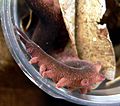Velvet worm facts for kids
Quick facts for kids Velvet worms |
|
|---|---|
 |
|
| A member of the Peripatidae family | |
| Scientific classification | |
| Kingdom: | |
| Superphylum: | |
| (unranked): | |
| Phylum: |
Onychophora
|
The velvet worms are amazing creatures also known as Onychophora. This name means "claw bearers," which describes their tiny claws. They are part of a larger group called Panarthropoda, which also includes arthropods (like insects and spiders) and tardigrades (water bears).
There are about 200 different kinds, or species, of velvet worms. They are divided into two main families. All velvet worms live on land, usually in damp or wet places in tropical areas around the world.
What are Velvet Worms?
Velvet worms look a bit like worms with many legs. They have small eyes and a soft, "furry" body. They also have antennae on their heads and special slime glands. These glands help them catch their food!
They are predators, meaning they hunt other smaller animals. They mostly eat insects. To catch their prey, velvet worms squirt a very sticky slime from their glands. This slime traps the insect, making it easy for the velvet worm to eat.
The two main families of velvet worms are called Peripatidae and Peripatopsidae. The Peripatidae family mostly lives near the equator in tropical regions. The Peripatopsidae family is found in areas that were once part of an ancient supercontinent called Gondwana. This includes places like Australia, New Zealand, and parts of South America.
Ancient Relatives of Velvet Worms
Scientists believe that velvet worms have a very long history. Fossils that look a lot like velvet worms have been found from a time called the early Cambrian period, which was over 500 million years ago!
These ancient fossils are known as lobopods. They were marine animals, meaning they lived in the ocean. Scientists think that lobopods were the ancestors of velvet worms, arthropods, and tardigrades.
Fossils of these ancient creatures have been found from different time periods, including the Cambrian, Ordovician (maybe), Silurian, and Pennsylvanian periods. For a long time, all fossil velvet worms and lobopods were grouped together. However, only a few of the Cambrian fossils have features that clearly link them to modern velvet worms. Two special examples are Hallucigenia and Collinsium ciliosum, which have claws that are very similar to those of today's velvet worms.
Images for kids
See also
 In Spanish: Onychophora para niños
In Spanish: Onychophora para niños



